Asparagus…Cook it Right and Every Recipe is Divine!
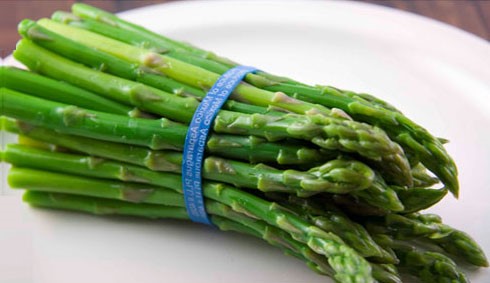
Don’t you think one of the best parts of spring is the foods that show up with the season? Asparagus, for instance. Springtime is prime time for asparagus, (the season peaks around April in most parts of the U.S).
I know though, that not all people love asparagus. The other day a couple friends were saying they didn’t like it at all because it was always so mushy. “Hmmm,” I thought to myself, “that’s a pity—apparently they’ve never had it cooked properly.”
So in the off chance any of our readers have the mushy-asparagus prejudice going on, I thought we should talk about it.
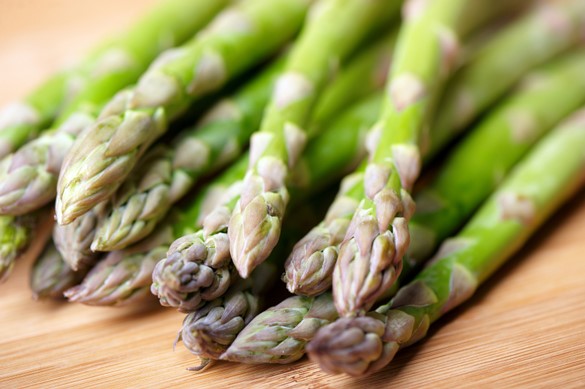
First, let’s discuss the shopping. Look for firm, bright green spears with healthy tips that are tight and not mushy. Spear size ranges from fat (these come from older plants) to pencil thin. Thin asparagus is tender with a slightly crisp center, while thick asparagus has more of a meaty center and therefore more crunch and texture. For thick asparagus spears, peel off the woody outside part (about 2 inches up from the stem end) with a vegetable peeler.
But whether you like skinny or fat spears, just be sure to choose those that are uniform in size for even cooking.
And when possible, enjoy your asparagus the day you purchase it. If that isn’t possible, wrap the bases in a damp paper towel, place the bundle in a plastic bag, and refrigerate it for up to four days. You can also stand the spears upright in a container filled with 1 inch of water. Cover the asparagus and the container with a plastic bag. Either method will keep the spears crisp and fresh.
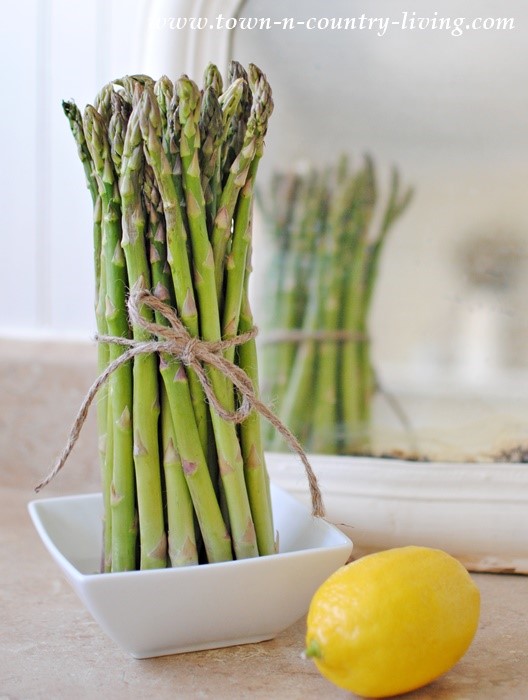
Another good thing to know is amounts. One pound of asparagus equals 18 to 24 spears or four servings.
Then there’s the actual prepping. Because asparagus is grown in sandy soil, you want to rinse it well (especially the tips) with cold water. Snap off the woody base of each spear by bending the spear a few times to find a place where it breaks easily (usually around the bottom third of the spear and where the woody part starts to turn tender). If desired, scrape off the scales on the spears with a vegetable peeler. This gives the spears a smooth, clean look and is especially beneficial for tough or fat spears.
Asparagus can be cooked so many ways—roasting/baking, grilling, steaming, simmering, microwaving, and blanching. I was introduced to the best ways to cook asparagus in an old Better Homes and Gardens magazine and have been using these techniques ever since. Here’s what the BHG experts do to get the perfect NON-MUSHY asparagus:
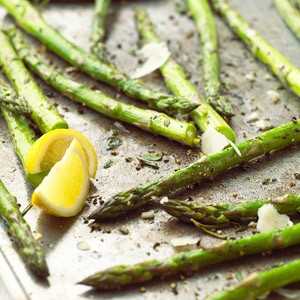
To roast: This is done in the oven at a high temperature. Here’s how: Preheat the oven to 450°. Place asparagus in a plastic bag with 1 or 2 tablespoons olive oil. Toss lightly to coat. Arrange spears on a baking sheet or in a baking dish and season with salt and black pepper. Roast, uncovered, about 15 minutes or until crisp-tender, lightly tossing twice during roasting. Seasoning with herbs and lemon is also a delicious touch.
To grill: This method gives is a light smoky flavor. Generously brush asparagus with olive oil or melted butter. This keeps them from sticking to the grill rack. Place asparagus on a piece of heavy foil or directly on the grill rack, perpendicular to the wires on the rack. For a charcoal grill, place asparagus on grill rack directly over the coals. Grill, uncovered, 7 to 10 minutes or until crisp-tender, turning occasionally. For a gas grill, preheat grill. Reduce heat to medium. Place asparagus on grill rack directly over heat. Grill, covered, 7 to 10 minutes or until crisp-tender, turning occasionally.
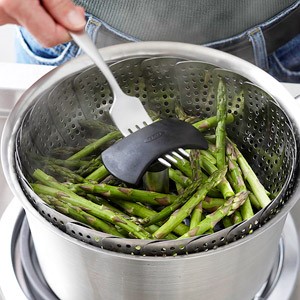
To steam: Place a steamer basket in a saucepan. Add water to just below the bottom of the basket. Bring water to boiling. Place asparagus in steamer basket. Cover and reduce heat. Steam for 3 to 5 minutes or until crisp-tender. (This is the best way to cook asparagus without adding fat.)
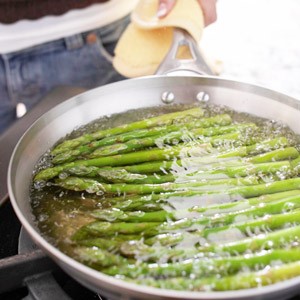
To simmer: When you simmer it on the stove, it's best to lightly salt the water. It flavors the asparagus as it cooks! Lay the spears in a large skillet and top with 1 inch of water. Lightly salt the water and bring to a simmer. Cook, covered, for 3 to 5 minutes or until crisp-tender.
To microwave: This is the easiest method ever! Place asparagus in a microwave-safe baking dish or casserole with 2 tablespoons water and 2 pats of butter. Microwave, covered, for 2 to 4 minutes or until crisp-tender.
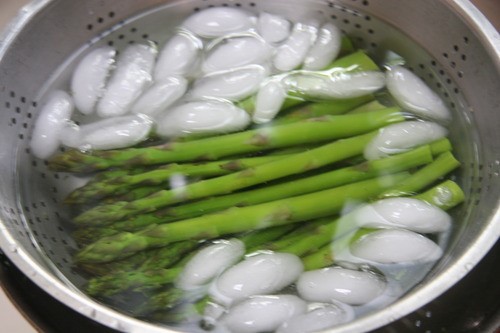
To blanche: Among the many ways to cook asparagus, blanching is classic. Blanched asparagus is excellent in salads and appetizers. You boil it, then shock it in an ice bath to stop the cooking, resulting in perfectly cooked yet cold asparagus. To make and serve warm right away without shocking, place asparagus in a single layer in a shallow baking dish. Cover with about 2 cups of salted boiling water. Let stand for 10 to 12 minutes until bright green and crisp-tender. Drain; serve warm.
I’ll close this asparagus primer with one last bit of encouragement: Asparagus never need turn up mushy. Cook it right and enjoyment follows! And now that you know how, try this recipe from Minimalist Baker (www.minimalistbaker.com). Chef Dana uses the roasting/baking approach on the asparagus. She says, “You must try this dish—it’s creamy, light, satisfying, simple, lemony, savory, loaded with veggies, and perfect for a quick-but-healthy weeknight meal.”
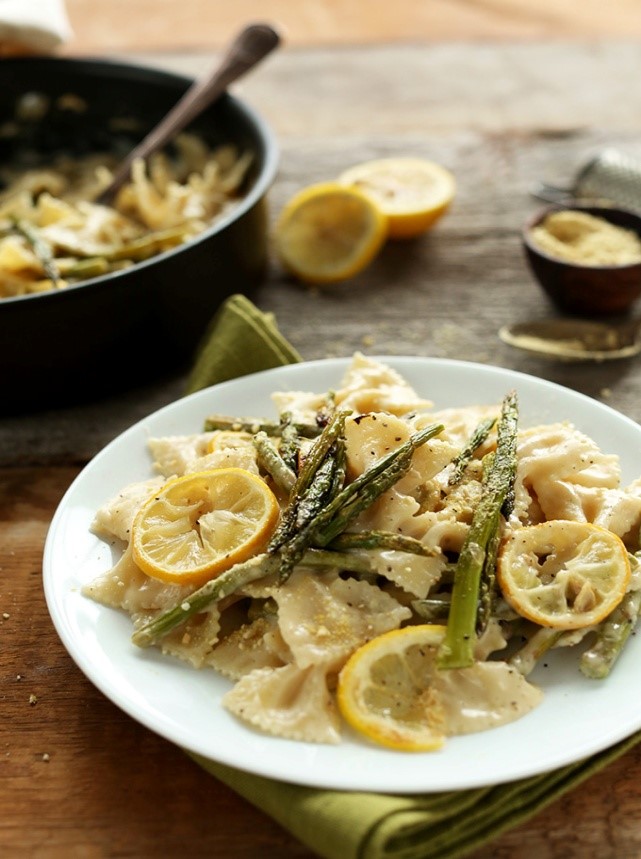
LEMON PASTA ASPARAGUS
1 bunch asparagus spears (12-16 ounces), trimmed and washed
Sea salt to taste
Black pepper to taste
2 lemons
Olive oil
3-4 large cloves garlic, minced (~2 Tbsp)
10 ounces (~5 cups) bow tie pasta (can easily substitute gluten free pasta)
2 ½ cups unsweetened plain almond milk
3-4 Tbsp all purpose flour (substitute another thickener if you’re gluten free)
1-2 Tbsp nutritional yeast (for a subtle cheesy flavor; optional)
Preheat oven to 400°F. Add asparagus to a baking sheet and toss with 1/2 Tbsp olive oil and a pinch each salt and pepper. Top with several thin slices of lemon and bake for 20-25 minutes. Once finished cooking, remove from oven and roughly chop into thirds.
In the meantime, bring a pot of water to a boil and salt generously. While the water’s heating, bring a large skillet to medium heat. Once hot, add 3 Tbsp olive oil and garlic. Whisk and continue cooking for 1-2 minutes or until garlic is just starting to brown.
Add 3 Tbsp flour and whisk. Cook for 30 seconds, then whisk in almond milk 1/2 cup at a time. TIP: Use a large flat spatula to smash down the bits of garlic and flour to properly incorporate. Add a healthy pinch salt and pepper and whisk. Slightly lower heat and continue cooking to thicken, stirring occasionally.
Add pasta to boiling water and cook according to package instructions. Then drain and set aside.
For extra creamy sauce, add sauce to a blender or use an immersion blender to blend. Add nutritional yeast and another pinch of salt and pepper. If it looks runny, add another Tablespoon of flour (or cornstarch). Blend until creamy and smooth, using the “puree” or “liquify” setting if possible. Taste and adjust seasonings as needed, then add back to pan and continue cooking over medium to medium-low heat to thicken.
Once your sauce has reached desired thickness, add the juice of half a lemon and stir. Add 3/4 of the chopped asparagus and the cooked pasta to the sauce and toss to coat. Divide between 2-3 serving plates and top with remaining asparagus. Serve with a lemon wedge and Parmesan cheese (optional). Store leftovers in the refrigerator for up to a few days.
NOTE: I added toasted nuts to this with divine results!
- www.siddheshagro.in
- www.blog.etundra.com
- www.yellowblissroad.com
- www.bhg.com
- www.minimalistbaker.com
- www.wikihow.com
 Alice Osborne
Alice Osborne
Weekly Newsletter Contributor since 2006
Email the author! alice@dvo.com
